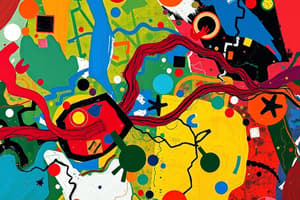Podcast
Questions and Answers
What is the primary method of hormone communication described in the text?
What is the primary method of hormone communication described in the text?
- Activation of protein kinases
- Interaction with extracellular receptors (correct)
- Binding to intracellular receptors
- Direct gene activation
How does an activated G protein affect adenylate cyclase?
How does an activated G protein affect adenylate cyclase?
- It has no effect on adenylate cyclase
- It inhibits adenylate cyclase activity
- It degrades adenylate cyclase
- It stimulates adenylate cyclase activity (correct)
Which molecule acts as the second messenger in the described signaling pathway?
Which molecule acts as the second messenger in the described signaling pathway?
- G protein
- Adenylate cyclase
- Protein kinase
- cAMP (correct)
What happens to a G protein after its GTP is hydrolyzed?
What happens to a G protein after its GTP is hydrolyzed?
What enzyme degrades cyclic AMP in the described pathway?
What enzyme degrades cyclic AMP in the described pathway?
Which type of G protein stimulates adenylate cyclase in the pathway?
Which type of G protein stimulates adenylate cyclase in the pathway?
What enzyme is responsible for splitting the plasma membrane phospholipid PIP2 into DAG and IP3 in the PIP2-Calcium signaling mechanism?
What enzyme is responsible for splitting the plasma membrane phospholipid PIP2 into DAG and IP3 in the PIP2-Calcium signaling mechanism?
Which of the following is NOT considered a second messenger in hormone signaling?
Which of the following is NOT considered a second messenger in hormone signaling?
In the PIP2-Calcium signaling mechanism, what is the function of the liberated Ca2+ ions?
In the PIP2-Calcium signaling mechanism, what is the function of the liberated Ca2+ ions?
What is the term for the process where a hormone increases receptor number or affinity due to rising physiological levels?
What is the term for the process where a hormone increases receptor number or affinity due to rising physiological levels?
Which phenomenon refers to the decreased receptor number or affinity due to prolonged exposure to high hormone concentrations?
Which phenomenon refers to the decreased receptor number or affinity due to prolonged exposure to high hormone concentrations?
In the context of hormone communication with target cells, what is the main function of G protein?
In the context of hormone communication with target cells, what is the main function of G protein?
What does cyclic AMP stand for in the context of second messenger method of hormone communication?
What does cyclic AMP stand for in the context of second messenger method of hormone communication?
What is the name given to the U-shaped relationship wherein there are high risks at both extremes of exposure to substances like vitamin A?
What is the name given to the U-shaped relationship wherein there are high risks at both extremes of exposure to substances like vitamin A?
How does the second messenger method of hormone communication proceed following activation of adenylate cyclase?
How does the second messenger method of hormone communication proceed following activation of adenylate cyclase?
Flashcards
Second Messengers
Second Messengers
Molecules that relay signals within cells, triggered by hormone binding to extracellular receptors.
Cyclic AMP (cAMP)
Cyclic AMP (cAMP)
A type of second messenger that activates protein kinase, leading to signal amplification.
cAMP Signaling Pathway
cAMP Signaling Pathway
A pathway where a hormone binds to its receptor, activating a G protein, which then activates adenylate cyclase and converts ATP to cAMP.
Gs Protein
Gs Protein
Signup and view all the flashcards
Phosphodiesterase
Phosphodiesterase
Signup and view all the flashcards
Calcium Signaling Mechanism
Calcium Signaling Mechanism
Signup and view all the flashcards
Phospholipase C
Phospholipase C
Signup and view all the flashcards
Diacylglycerol (DAG)
Diacylglycerol (DAG)
Signup and view all the flashcards
Inositol Triphosphate (IP3)
Inositol Triphosphate (IP3)
Signup and view all the flashcards
Calmodulin
Calmodulin
Signup and view all the flashcards
Insulin
Insulin
Signup and view all the flashcards
Regulation of Hormone Receptors
Regulation of Hormone Receptors
Signup and view all the flashcards
Up-regulation
Up-regulation
Signup and view all the flashcards
Down-regulation
Down-regulation
Signup and view all the flashcards
Dose-Response Curve
Dose-Response Curve
Signup and view all the flashcards
Study Notes
Hormone Signaling
- Hormones bind to extracellular receptors, generating an intracellular molecule that mediates a response
- Second messengers are molecules that transmit signals from hormones within the cell
- There are different types of second messengers, including cyclic AMP (cAMP), cyclic GMP (cGMP), DAG, and IP3
cAMP Signaling Pathway
- When a hormone binds to its receptor, the receptor changes shape and activates a nearby inactive G protein
- The G protein, now active, moves along the plasma membrane and binds to adenylate cyclase
- Adenylate cyclase converts ATP to cyclic AMP (cAMP) with the help of a Gs protein
- cAMP activates protein kinase, an enzyme that adds a phosphate group to various proteins, amplifying the signal
- cAMP is degraded by the enzyme phosphodiesterase
Calcium Signaling Mechanism
- This pathway uses a G protein (Gq) and the enzyme phospholipase C
- Phospholipase C splits PIP2 into DAG and IP3
- DAG activates protein kinase, which triggers a response in the cell
- IP3 releases Ca2+ from intracellular storage sites, which bind to calmodulin
- The Ca2+-calmodulin complex activates enzymes that amplify the cellular response
Insulin Signaling Pathway
- Insulin binds to its receptor, activating its tyrosine kinase activity
- The activated insulin receptor serves as a docking site for intracellular relay proteins
- These proteins initiate a series of phosphorylations, triggering a cellular response
Regulation of Hormone Receptors
- Receptor numbers and affinity can change in response to hormone levels
- Up-regulation: increased receptor number or affinity due to rising hormone levels
- Down-regulation: decreased receptor number or affinity due to prolonged exposure to high hormone levels
Dose-Response Curve
- A graph showing the level of exposure (dose) and risk (increasing or decreasing) of an outcome
- Can be applied to substances other than hormones
- Threshold dose: the dose below which no effects are seen
- U-shaped relationship: high risks at both extremes of exposure
Hormone Communication Methods
- Two primary methods: second messenger and direct gene activation
- Second messenger method: hormone binds to receptor, activating a G protein, which generates a second messenger that triggers a response
- Direct gene activation method: hormone binds to receptor, which activates genes directly, without a second messenger
Studying That Suits You
Use AI to generate personalized quizzes and flashcards to suit your learning preferences.




